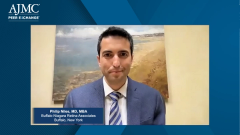
Impact of Therapy Delays in Wet AMD and DME
Philip Niles, MD, MBA; Jim Kenney, RPh, MBA; and Nicholas G. Anderson, MD, discuss the clinical and economic implications of a delay in therapy for wet AMD and DME.
Episodes in this series

Jim Kenney, RPh, MBA: What are the clinical and economic implications of a delay in therapy for wet AMD [age-related macular degeneration]? If we’ve got this step in place or a requirement to get a special approval, that obviously can delay therapy. What’s the potential long-term impact, clinical and economical, in this population?
Philip Niles, MD, MBA: The clinical and economic impacts of a delay in care for wet macular degeneration are huge and oftentimes irreversible. If a patient starts forming what we call subretinal fibrosis or scar tissue where they used to have a blood vessel, you can’t fix that. So for us, I think the key thing is having the patient come into the office once their symptoms start. That’s really the most important thing. With the advent of home monitoring tools, this might be a bit more possible going forward. Another thing I think about with delay in therapy is matching the right medication to the proper patient. For instance, right now in our field, there are some physicians who will start doing injections even if they’re not retina specialists, but they’ll only use 1 medication, as opposed to what Dr. Anderson was talking about, using all 4 medications to find the best fit for the patient. Then if that 1 medication isn’t working well for a while, then they often get referred to a retina specialist. That delay in getting to the right thing oftentimes requires them to need more treatments down the road of a more expensive medication. That tremendously increases costs, I would say. But the big thing, just like with any condition, is early detection leads to better outcomes.
Nicholas G. Anderson, MD: I think we unfortunately had a very interesting real-world trial several years ago with the advent of the COVID-19 epidemic. We saw so many patients who were not coming in for treatment, understandably. Many physicians actually closed their practices altogether. Many patients understandably were concerned about coming in, and unfortunately as the pandemic progressed and we started to see patients trickling back in who had missed some treatments, we saw many very unfortunate instances of severe hemorrhaging in the macula that resulted in permanent vision loss. And unfortunately, the patients would say, “Hey, I’m back, I’m ready to resume therapy. I’m anticipating my vision will get right back to where it was in February,” and that is just not the case. If a patient has significant progression, the majority of the time you can’t make that back again. And we tragically saw the results of that with the advent of the pandemic a few years ago.
Philip Niles, MD, MBA: It hurts to see that, doesn’t it?
Nicholas G. Anderson, MD: It’s very painful. It’s very painful.
Jim Kenney, RPh, MBA: We saw that across the industry. You saw the significant reduction in expense at the health plan level, which generated some reimbursement of premiums per the medical loss ratio requirements of the ACA [Affordable Care Act]. So clearly the plans weren’t spending money on patient treatments because the patients couldn’t get in to get treated. And that was broadly across all different indications. We hear that in the oncology space, a lot of significant oncology progression in patients who weren’t able to get in for treatment. I think that’s a great point, and something you can see and document, the progression in patients who were treated regularly and then you stop treatment. You can really appreciate the loss of vision when that happens.
Nicholas G. Anderson, MD: We certainly don’t want to be penny-wise and pound-foolish, but what we see, not uncommonly, especially in the patients with diabetic macular edema, for example, is if they’re not being treated adequately, then the vision starts to get worse. Oftentimes we’ll get to the point where they can no longer draw up their insulin or administer their insulin appropriately. So the loss of vision that we see due to inadequate treatment leads to worsening systemic health outcomes. It tends to feed itself, unfortunately.
Jim Kenney, RPh, MBA: This was a great conversation.
Transcript Edited for Clarity
Newsletter
Stay ahead of policy, cost, and value—subscribe to AJMC for expert insights at the intersection of clinical care and health economics.




























































